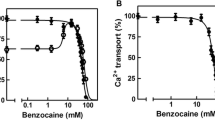Summary
Normal frog sartorius muscles and muscles in which a major portion of the intracellular K+ was reversibly replaced by Rb+ or Cs+ were frozen, freeze-dried and embedded without chemical fixation or staining. Dry-cut sections of these preparations reveal striation patterns with higher contrast than those of wet-cut sections of the same preparation. The results suggest that in the living state the alkali metal ions are mainly localized in the A bands and Z lines of myofibrils. This idea is confirmed by a new autoradiographic technique by means of which the distribution of Rb+ and Cs+ in frozen-hydrated single muscle fibers has been investigated. The findings support the association-induction hypothesis according to which most cell K+ and other alkali-metal ions are not free in cell water but are adsorbed to beta- and gamma-carboxyl groups of cell proteins.
Similar content being viewed by others
References
Edelmann L (1977) Potassium adsorption sites in frog muscle visualized by cesium and thallium under the transmission electron microscope. Physiol Chem Phys 9:313–317
Edelmann L (1978a) A simple freeze-drying technique for preparing biological tissue without chemical fixation for electron microscopy. J Microsc (Oxford) 112:243–248
Edelmann L (1978b) Visualization and x-ray microanalysis of potassium tracers in freeze-dried and plastic embedded frog muscle. Microsc Acta Suppl 2:166–174
Edelmann L (1979) Freeze-drying of chemically unifixed biological material for electron microscopy. Mikroskopie 35:31–36
Ernst E (1963) Biophysics of the striated muscle. Publication House Hungarian Academy of Sciences, Budapest
Fenn WO (1936) Electrolytes in muscle. Physiol Rev 16:450–487
Gersh I (1938) Improved histochemical methods for chloride, phosphate-carbonate and potassium applied to skeletal muscle. Anat Rec 70:311–329
Giese W, Rekowski C (1970) Autoradiographische Untersuchungen über die zelluläre Verteilung von Cs-134 in Organen von Ratten. Zentralbl Veterinärmed Beiheft 11:198–205
Ling GN (1952) The role of phosphate in the maintenance of the resting potential and selective ionic accumulation in frog muscle cells. In: McElroy WD, Glass B (eds) Phosphorous metabolism vol II. The Johns Hopkins University Press, Baltimore, pp 748–795
Ling GN (1962) A physical theory of the living state: The association-induction hypothesis. Blaisdell, Waltham, MA
Ling GN (1977a) Thallium and cesium in the muscle cells compete for the adsorption sites normally occupied by K+. Physiol Chem Phys 9:217–222
Ling GN (1977b) K+ localization in muscle cells by autoradiography, and identification of K+ adsorbing sites in living muscle cells with uranium binding sites in electron micrographs of fixed cell preparations. Physiol Chem Phys 9:319–327
Ling GN (1973) How does ouabain control the levels of K+ and Na+? By interference with a Na pump or by allosteric control of Na-K adsorption on cytoplasmic protein sites? Physiol Chem Phys 5:295–311
Ling GN (1978a) Maintenance of low sodium and high potassium levels in resting muscle cells. J Physiol 280:105–123
Ling GN (1978b) Two opposing theories of the cellular electrical potential: A quarter of a century of experimental testing. Bioelectrochem Bioenerg 5:411–419
Ling GN (1979) The equations for cellular resting potentials according to the surface adsorption theory, a corollary of the association-induction hypothesis. Physiol Chem Phys 11:59–63
Ling GN, Bohr G (1971) Studies of ionic distribution in living cells: IV Effect of ouabain on the equilibrium concentrations of Cs+, Rb+, K+, Na+ and Li+ ions in frog muscle cells. Physiol Chem Phys 3:573–583
Ling GN, Peterson K (1977) A theory of cell swelling in high concentrations of KCl and other chloride salts. Bull Math Biol 39:721–741
Locker RH, Leet NG (1975) Histology of highly-stretched beef muscle. I. The fine structure of grossly stretched single fibers. J Ultrastruct Res 52:64–75
Macallum AB (1905) On the distribution of potassium in animal and vegetable cells. J Physiol 32:95–128
MacKenzie AP (1965) Factors affecting the mechanism of transformation of ice into water vapor in the freeze-drying process. Ann NY Acad Sci 125:522–547
Nesterov VP, Tigyi-Sebes A (1965) Localization of myofibrillar potassium with sodium tetraphenylborate. Acta Physiol Acad Sci Hung 28:97–104
Rogers AW (1969) Techniques of autoradiography. Elsevier, New York
Sitte H (1979) Cryofixation of biological material without pretreatment — a review. Mikroskopie 35:14–20
Spurr AR (1969) A low viscosity epoxy resin embedding medium for electron microscopy. J. Ultrastruct Res 26:31–43
Szentkuti L, Giese W (1973) Autoradiographische Untersuchungen über die zelluläre Verteilung von Cäsium-134 in der Skelettmuskulatur von Mäusen. Histochemie 34:211–216
Thomson WW, Berry WL, Liu LL (1969) Localization and secretion of salt by the salt glands of Thamarix aphylia. Proc Natl Acad Sci 63:310–317
Troschin AS (1958) Das Problem der Zellpermeabilität. Gustav Fischer Jena
Author information
Authors and Affiliations
Rights and permissions
About this article
Cite this article
Edelmann, L. Potassium binding sites in muscle: Electron microscopic visualization of K, Rb, and Cs in freeze-dired preparations and autoradiography at liquid nitrogen temperature using86Rb and134Cs. Histochemistry 67, 233–242 (1980). https://doi.org/10.1007/BF00692757
Received:
Accepted:
Issue Date:
DOI: https://doi.org/10.1007/BF00692757




